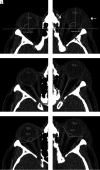Imaging the Tight Orbit: Radiologic Manifestations of Orbital Compartment Syndrome
- PMID: 36997289
- PMCID: PMC10171392
- DOI: 10.3174/ajnr.A7840
Imaging the Tight Orbit: Radiologic Manifestations of Orbital Compartment Syndrome
Abstract
Background and purpose: Orbital compartment syndrome is a sight-threatening emergency caused by rising pressure inside the orbit. It is usually diagnosed clinically, but imaging might help when clinical findings are inconclusive. This study aimed to systematically evaluate imaging features of orbital compartment syndrome.
Materials and methods: This retrospective study included patients from 2 trauma centers. Proptosis, optic nerve length, posterior globe angle, morphology of the extraocular muscles, fracture patterns, active bleeding, and superior ophthalmic vein caliber were assessed on pretreatment CT. Etiology, clinical findings, and visual outcome were obtained from patient records.
Results: Twenty-nine cases of orbital compartment syndrome were included; most were secondary to traumatic hematoma. Pathologies occurred in the extraconal space in all patients, whereas intraconal abnormalities occurred in 59% (17/29), and subperiosteal hematoma in 34% (10/29). We observed proptosis (affected orbit: mean, 24.4 [SD, 3.1] mm versus contralateral: 17.7 [SD, 3.1] mm; P < .01) as well as stretching of the optic nerve (mean, 32.0 [SD, 2.5] mm versus 25.8 [SD, 3.4] mm; P < .01). The posterior globe angle was decreased (mean, 128.7° [SD, 18.9°] versus 146.9° [SD, 6.4°]; P < .01). In 69% (20/29), the superior ophthalmic was vein smaller in the affected orbit. No significant differences were detected regarding the size and shape of extraocular muscles.
Conclusions: Orbital compartment syndrome is characterized by proptosis and optic nerve stretching. In some cases, the posterior globe is deformed. Orbital compartment syndrome can be caused by an expanding pathology anywhere within the orbit with or without direct contact to the optic nerve, confirming the pathophysiologic concept of a compartment mechanism.
© 2023 by American Journal of Neuroradiology.
Figures




Comment in
-
The Benefits of Ocular Ultrasound in Emergency Settings for the Evaluation of Orbital Compartment Syndrome.AJNR Am J Neuroradiol. 2023 Aug;44(8):E38-E39. doi: 10.3174/ajnr.A7904. Epub 2023 Jul 27. AJNR Am J Neuroradiol. 2023. PMID: 37500282 Free PMC article. No abstract available.
References
MeSH terms
LinkOut - more resources
Full Text Sources
